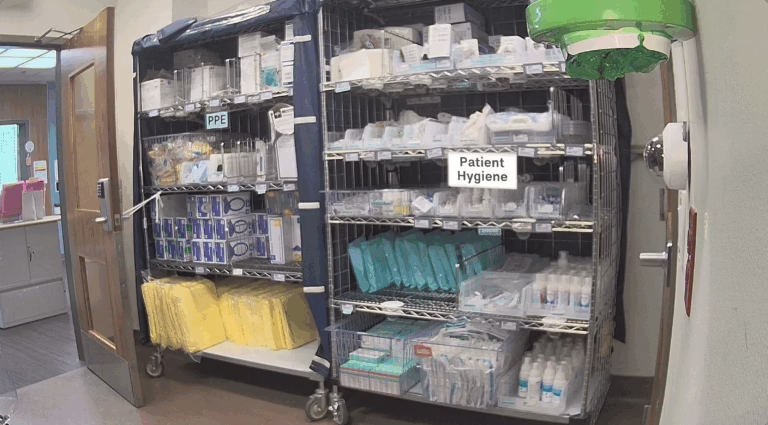Hospitals are reevaluating inventory tools that were built for a different era. Barcode programs improved accuracy but depend on perfect compliance. RFID sped up scanning but still requires tags, readers, and periodic sweeps. AI hospital inventory management shifts the model from episodic counts to continuous awareness. The question is not barcode versus RFID. The question is where always-on vision and data can remove blind spots fastest for care teams and supply chain leaders.
Continuous visibility without manual scans
Most gaps begin with time lags between use and record. Vision systems monitor shelves and bins in real time, so counts update as clinicians take items. That means fewer blind spots and fewer end-of-shift reconciliations. The result is reliable inventory visibility across high-value rooms and general supply closets, not just specialty cabinets.
Because the signal comes from cameras rather than handhelds, staff do not stop to scan. This touchless inventory model reduces interruptions and frees time for patient care. It also records context, such as whether a full case or a single unit moved, which improves downstream accuracy. The principle aligns with zero-touch inventory management, which removes manual steps from routine replenishment.
How AI hospital inventory management changes the baseline
Traditional tools infer demand from past orders. Vision-driven systems capture actual consumption as it happens. That baseline supports more accurate planning, fewer urgent orders, and better collaboration with clinical leaders who need confidence that essentials will be ready.
Less counting, higher accuracy
Barcode programs are low cost but depend on perfect compliance. Missed scans compound into errors that require cycle counts to fix. RFID reduces friction but still needs tags on items, readers near doors, and ongoing maintenance. By contrast, hospital inventory automation records movement without taps or badges. Over time, the data quality benefit grows, since each movement is captured in the same way across rooms and shifts.
Accuracy gains do not end at counts. When teams trust the numbers, they order with confidence. That reduces variation, lowers safety stock, and strengthens case preparation in procedural areas. The same foundation improves inventory visibility for finance and operations, which enables better reporting and governance.
From forecasting to predictive restocking
Granular signals support smarter planning. With consistent shelf-level data, teams can shift from static PARs to models that anticipate use based on seasonality, lead times, and service line patterns. The outcome is fewer overcorrections and faster recovery when demand changes. In practice, AI hospital inventory management supports predictive restocking that tunes reorder points before shortages occur.
Operating cadence also changes. Vision and data make replenishment steady and repeatable instead of episodic. This approach reflects an autonomous operating model for supply rooms that standardizes work while preserving local flexibility. Predictive restocking improves vendor collaboration as well. With more accurate signals, hospitals can align deliveries to actual consumption and reduce emergency fees. That supports better service levels for clinicians and fewer weekend scrambles for materials teams.
Fewer stockouts and less waste
Waste and rush orders remain costly. Analyses show hospitals overspend by about $25 billion each year on supply chain expenses that could be avoided with better data and process control. Continuous signals make shortages visible sooner and help teams act before a case is at risk. This touchless inventory model also curbs expired items, since slow movers are easier to flag and redeploy.
Real-time tracking supports proactive decisions at shift changes and across sites. Teams can see low items in one closet and route available stock from another before placing an urgent order. That reduces substitutions and protects clinical workflows. It also supports quality review, since leaders can see the sequence of events that led to a shortage and address root causes.
Integration, governance, and scale
The value does not come from cameras alone. It comes from how signals flow into ERP and materials systems and how leaders manage exceptions. Hospital inventory automation integrates with purchasing and dispensing so the same data drives ordering, receiving, and charge capture. That supports audit trails, strengthens contract compliance, and improves formulary stewardship.
Governance matters as scale grows. Consistent metrics, standard room layouts, and clear roles reduce variance across facilities. External benchmarks can help align targets for fill rates, service levels, and cost to serve. A performance-oriented supply chain can reduce supply spend by up to 10% while improving resilience and clinician satisfaction, according to independent analyses.
Why this wins
Continuous signals fix the root of the problem. Real-time shelf awareness improves day-to-day reliability for clinicians. Fewer blind spots lower waste and cut emergency fees. Predictive planning reduces volatility and protects case readiness. Integration and governance make the gains durable across sites and service lines. These outcomes and metrics align with five ways AI is transforming healthcare inventory management.
What to standardize next
Set clear goals before selecting technology. Define the rooms, items, and workflows that create the most risk. Align metrics with finance and clinical leaders so success is shared. Use pilots to validate baseline accuracy, service levels, and reorder logic, then expand by cohort. Weave training into daily huddles so teams understand how the system supports their work. AI hospital inventory management works best when governance and change management move in step with the data.
If you want to move beyond episodic counts and into continuous control, schedule a consultation to discuss scope, goals, and how to align the model with your ERP and clinical priorities.




